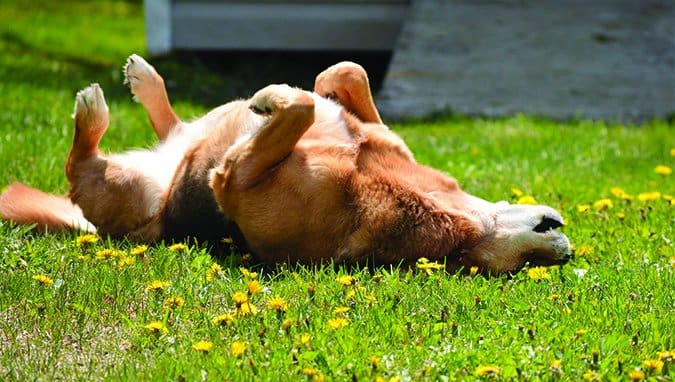Raise your hand if you have a perfectly trained dog. Anyone? Anyone? If you raised your hand, good for you! – both of you! For the rest of us whose hands didn’t budge, the reality is a little different. Many of us have a long laundry list of dog behaviors we’d like to work on, eventually.
The list of dog training goals may be quirky little things, ranging from stealing tissues out of the bathroom garbage bin to barking at the sound of a doorbell on TV, digging up the vegetable garden, and snacking from the cat’s litter box.
Your list of dog training goals might also include more serious issues, like your dog behaving aggressively toward strangers, slipping through any door left open and making a run for it, or displaying fearful behaviors when left at home alone. These types of canine behavior problems absolutely deserve our attention and should be addressed sooner rather than later for the safety of others, as well as for the safety and well being of the dog.
But what about those other issues? Is it okay to ignore them? I mean, if it’s not a problem for you, then is it a problem at all?

Establish Training Goals for Your Dog
Recently I celebrated the fifth anniversary of my dog Chili’s adoption. I originally brought her into my home as a foster, because she had been a resident of the local shelter for a while; I planned to work on some of her behavior issues in order to increase her chances of adoption. Chili exhibited a host of behaviors that would be problematic for most families: she knew how to perform zero behaviors on cue, had never learned to walk on a leash, she guarded her food and bones, barked and lunged against the windows when riding in the car, and barked and lunged at the TV when a dog barked on screen – to name just a few.
After a couple of weeks, and once I realized the scope of her behavior problems, I went ahead and signed the adoption papers just to avoid sending Chili back to the shelter when my previously agreed-upon two weeks of fostering were up. I was still going to try to find her a suitable home while we worked on her behavior, however; she wasn’t actually going to stay with us forever.
Weeks turned into months, and by then, my family had grown so attached to Chili that we had no intention of letting her go live elsewhere. She had become a member of our family, as imperfect as she was. And despite nearly nonstop training for more than a year, she really was imperfect. Every day had been, in my eyes, an opportunity to work on at least one of her issues, a chance to improve her behavior, an obligation to turn her into a “good family dog.” Even though I aim to make training as much fun as possible for any dog I’m working with, the fact remains that for Chili, school was always in session. There had been no holidays, no summer break.
After 15 months of this, and during a time of mourning as we dealt with the unexpected loss of our other very special family dog to a sudden illness, it finally dawned on me that a dog’s life is much too short for me to be worrying about achieving perfect behavior. Why was I so concerned? What was I trying to prove, exactly, by constantly evaluating, managing, and tweaking Chili’s behavior?
I thought about it long and hard and came to the conclusion that my motivation to keep training Chili was rooted in pressure – pressure I put on myself, and pressure I imagined coming from other sources. Expectations had grown from the fact that I was a professional trainer, and yet my dog was not perfect. The social pressure – whether real or imagined – that I felt when I was out and about with my imperfect dog was weighing heavily on me.
Focus on Your Dog’s Good Behavior to Achieve Better Behavior
At that very moment, I stopped the daily training and the endless micromanagement of Chili’s every move and social contact. I pledged to her that I would instead focus on making what’s left of her unfairly short canine life the most fabulous time she had ever known. Expectations and judgment from others be damned, I was going to let Chili be Chili.
This approach has allowed us to relax and grow even closer. By taking a step back and getting to know her true personality, I have also come to realize there are a lot of things that Chili does well. I had spent so much time focusing on what was wrong, that I hadn’t really noticed what was right: She has never gone shopping in any garbage bins. She doesn’t bark when someone rings the doorbell or knocks at the door. She greets visitors with charm and class. She has always done her business in a far corner of the yard, without any coaching from me. . . . It turns out she’s a pretty awesome family dog, just the way she is!
This was such a defining moment for me that I now spend a lot of time helping clients to also see the good in their dog at a time when they might feel frustrated about a particular behavior problem.
Teaching a dog new behaviors can be lots of fun, and there are tons of people and dogs who thoroughly enjoy daily training and engaging in various canine sports or activities. However, it’s equally important to give yourself permission to take the pressure off of yourself and your dog if frequent training isn’t your thing.
If there are behavior issues that you simply can’t live with, then of course you should teach your dog to behave differently, or find a trainer who can show you how to make training fun for both you and your dog.
But if you feel you need to work on a behavior just because you think that’s what is expected of your dog, when really you could just as happily leave it alone, then by all means let it be and carry on as you were! It’s far more important that you and your dog enjoy the time you spend together.
The truth is, there is no such thing as a perfect dog, and there is no official rule book that states exactly how every dog should behave. We get to make up most of those rules based on what works for us and our own dogs. Outside of competitive dog sports or dog shows, there is no prize for perfect dog behavior. If your dog is good enough for you, and you’re able to make the most out of those dog years, then you’re already winners.
Nancy Tucker, CPDT-KA, is a full-time trainer, behavior consultant, and seminar presenter in Quebec, Canada. She has written numerous articles on dog behavior focusing on life with the imperfect family dog.







Thank you for this article. I have a 5 1/2 month old dachshund, and have taken him to 2 puppy classes. He becomes so full of anxiety that he disrupts the class by barking, and the last time he managed to do # 1 and 2 on the floor!
I have decided that I will work on the issues that he needs training in- at home. I am still working on potty training, chewing and pulling on lease. Other than that, he is a perfect baby and wonderful new member of our family since losing his older brother on 11/21/18. I thank you for this article again, and for me, I will love, and train him at home for what I feel he needs.